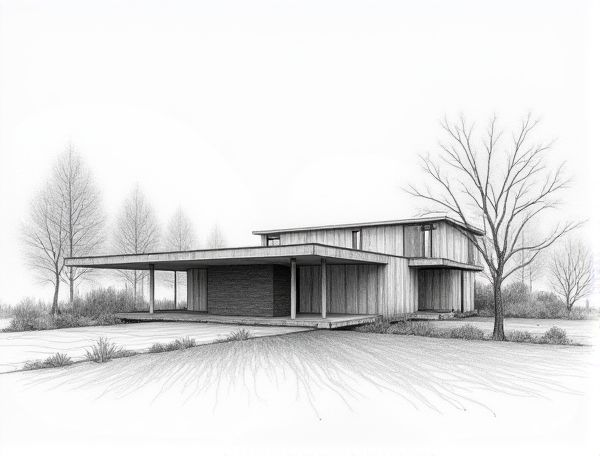
Photo illustration: Passive solar home design with trombe walls
Passive solar home design with Trombe walls maximizes natural heating by capturing and slowly releasing solar energy, reducing your reliance on traditional heating systems. Explore the article to learn how Trombe walls can enhance your home's energy efficiency and comfort year-round.
Introduction to Passive Solar Home Design
Passive solar home design maximizes natural sunlight to heat and light your living space efficiently, reducing energy costs and environmental impact. By strategically positioning windows, walls, and floors to absorb, store, and distribute solar energy, your home maintains comfortable temperatures year-round without relying heavily on mechanical systems.
Understanding Trombe Walls: Basics and Benefits
Trombe walls are passive solar building elements composed of a dark, heat-absorbing surface behind glass that captures and radiates heat into a home, enhancing energy efficiency. Their thermal mass stores solar energy during the day and releases warmth at night, reducing heating costs and improving indoor comfort.
Key Principles of Passive Solar Heating
Passive solar heating relies on strategic home orientation, maximizing southern exposure to capture sunlight during winter months and minimize heat loss. Thermal mass materials such as concrete or stone store solar energy, releasing warmth gradually to regulate indoor temperatures efficiently. Your home's insulation and window placement play critical roles in optimizing energy savings and maintaining consistent indoor comfort throughout the year.
How Trombe Walls Work: Thermal Dynamics Explained
Trombe walls capture solar energy by absorbing sunlight through a dark, heat-retaining surface behind glass, then slowly releasing the stored heat into your home, optimizing thermal regulation. This passive solar design leverages thermal mass and convection to reduce heating costs while maintaining indoor comfort efficiently.
Critical Design Elements for Effective Trombe Walls
Effective Trombe walls require optimal thermal mass materials such as concrete or adobe to absorb and store solar heat efficiently. Proper orientation toward the sun, typically south-facing in the northern hemisphere, maximizes solar gain, while adequate air circulation through strategically placed vents enhances heat distribution. Incorporating high-performance glazing reduces heat loss, ensuring consistent temperature regulation and improved energy efficiency in passive solar home design.
Material Selection for Trombe Wall Construction
Selecting thermally efficient materials like dense masonry, such as concrete or brick, is crucial for Trombe wall construction to maximize heat absorption and retention. Incorporating high solar absorptivity paint on the wall's exterior enhances thermal performance by increasing heat capture. Using glazing materials with low emissivity and high solar transmittance ensures optimal sunlight penetration while minimizing heat loss.
Optimal Placement and Orientation Strategies
Optimal placement and orientation strategies in home designing maximize natural light and enhance energy efficiency by aligning rooms with the sun's path. Positioning living areas toward south-facing windows captures warmth during winter months, reducing heating costs. Your home's layout can significantly benefit from strategic window placement, minimizing glare while promoting ventilation for superior indoor comfort.
Integration with Other Passive Solar Features
Incorporating thermal mass walls alongside strategically placed south-facing windows enhances heat retention and distribution, optimizing passive solar performance. Seamless integration with natural ventilation systems and overhangs ensures effective temperature regulation and maximizes energy efficiency throughout the home.
Real-World Examples of Homes Using Trombe Walls
Homes utilizing Trombe walls, such as the Solana Passive House in Arizona and the La Maison Passive in France, demonstrate significant energy savings by harnessing solar thermal mass for passive heating. Your design can replicate these examples to optimize natural heat retention and reduce reliance on conventional heating systems.
Energy Efficiency and Long-Term Cost Savings
Energy-efficient home design incorporates advanced insulation, high-performance windows, and smart HVAC systems to reduce energy consumption and lower utility bills significantly. Using sustainable materials and integrating renewable energy sources like solar panels enhance long-term cost savings by minimizing maintenance and operational expenses. Your investment in energy-efficient features not only promotes environmental responsibility but also increases the overall value of your home.
 homedesy.com
homedesy.com